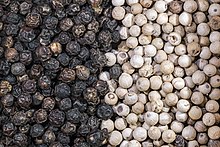This article has multiple issues. Please help improve it or discuss these issues on the talk page. (Learn how and when to remove these messages)
|





Bioenhancers or biopotentiators[1] or bioavailability enhancers is a new chapter in medical science first scientifically established in 1979 after the discovery of world's first bioenhancer piperine.[2] It is a pocket friendly drug technology which reduces the destruction, wastage and elimination of several orally administered drugs inside the body.
Definition Bioenhancers are defined as substances that increase the bioavailability leading to increased bioefficacy of active substances with which they are combined without having any pharmacological activity of their own at the dose used.[1] They may enhance bioavailability of allopathic drugs, vitamins, nutrients and toxins depending on its mechanism of action. For example, piperine increases bioavailability of several nutrients such as beta-carotene,[3] vitamin A, vitamin B6, coenzyme Q10,[4][5] drugs such as phenytoin,[6] theophylline,[7] propanolol[7] and a toxin called aflatoxin B1.[8]
Increased Bioavailabiity means increased levels of drug in the blood stream available for drug action. Increased Bioefficacy means the increased effectiveness of the drug due to increased bioavailability or due to other mechanisms.
- ^ a b Randhawa GK, Kullar JS, Rajkumar (January 2011). "Bioenhancers from mother nature and their applicability in modern medicine". International Journal of Applied & Basic Medical Research. 1 (1): 5–10. doi:10.4103/2229-516X.81972. PMC 3657948. PMID 23776764.
- ^ Atal CK (1979). "A breakthrough in drug bioavailability-a clue from age old wisdom of Ayurveda". IDMA Bulletin: 483–484.
- ^ Badmaev, Vladimir; Majeed, Muhammed; Norkus, Edward P. (1999). "Piperine, an alkaloid derived from black pepper increases serum response of beta-carotene during 14-days of oral beta-carotene supplementation". Nutrition Research. 19 (3): 381–388. doi:10.1016/S0271-5317(99)00007-X. ISSN 0271-5317.
- ^ Atal N, Bedi KL (April 2010). "Bioenhancers: Revolutionary concept to market". Journal of Ayurveda and Integrative Medicine. 1 (2): 96–9. doi:10.4103/0975-9476.65073. PMC 3151395. PMID 21836795.
- ^ Badmaev V, Majeed M, Prakash L (February 2000). "Piperine derived from black pepper increases the plasma levels of coenzyme Q10 following oral supplementation". The Journal of Nutritional Biochemistry. 11 (2): 109–13. doi:10.1016/s0955-2863(99)00074-1. PMID 10715596.
- ^ Bano G, Amla V, Raina RK, Zutshi U, Chopra CL (December 1987). "The effect of piperine on pharmacokinetics of phenytoin in healthy volunteers". Planta Medica. 53 (6): 568–9. doi:10.1055/s-2006-962814. PMID 3444866. S2CID 260249825.
- ^ a b Bano G, Raina RK, Zutshi U, Bedi KL, Johri RK, Sharma SC (1991). "Effect of piperine on bioavailability and pharmacokinetics of propranolol and theophylline in healthy volunteers". European Journal of Clinical Pharmacology. 41 (6): 615–7. doi:10.1007/BF00314996. PMID 1815977. S2CID 28817165.
- ^ Allameh A, Saxena M, Biswas G, Raj HG, Singh J, Srivastava N (January 1992). "Piperine, a plant alkaloid of the piper species, enhances the bioavailability of aflatoxin B1 in rat tissues". Cancer Letters. 61 (3): 195–9. doi:10.1016/0304-3835(92)90287-6. PMID 1739943.